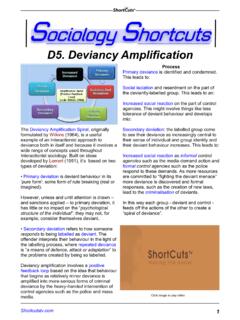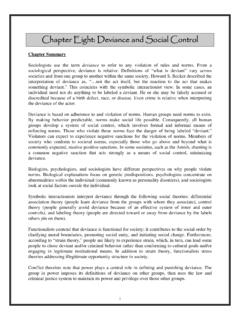Transcription of Functionalism and Crime – Merton’s Strain Theory
1 Functionalism and Crime Merton s Strain TheoryA Level SociologyStarterThink of goals that you want to achieveHow are you going to achieve those goals? The Big Question: Evaluate the usefulness of Merton s explanations to our understanding of Crime and deviance Define what is meant by Strain TheoryExplain how Strain occurs Outline deviant adaptations to strainEvaluate Merton s explanation of CrimeCompare and contrast Durkheim and Merton s viewsEvaluate both views and their usefulnessEA*What is a Strain Theory ? Argue that people engage in deviant behaviour when they cannot achieve goals by appropriate means Robert K Merton developed the first Strain Theory in 1938 it have two key elements.
2 Structural factors Cultural factors Merton Strain Theory Structural factors society s unequal opportunity structure Cultural factors emphasis on achieving goals, less emphasis on legitimate means to achieve themMerton Strain Theory For Merton deviance is the result of a Strain between the goals that a culture encourages and how the structure of society allows them to achieve these things legitimately Merton argued that in the USA the pursuit of the American Dream leads to deviant and criminal behaviour What is the American Dream? Ideology of American Dream American culture values money success individual wealth and high status Americans are expected to pursue this through hard-work, self-discipline.
3 Educational qualificationsOpportunities for all meritocraticReality of American Dream Disadvantaged groups denied opportunities ethnic groups disproportionate in poverty and unemployment Resulting Strain between goals and means creates pressure to resort to illegitimate means the Strain to anomie Merton s Strain TheoryGoalsDesire to succeed MeansPressure to succeed causes devianceDevianceLimited opportunities to achieve goals by legitimate means Deviant adaptations to strainMerton used Strain Theory to explain patterns of deviance in societyArgued that individual will adapt to Strain in one of five ways Conformity Innovation Ritualism Retreatism Rebellion Conformity Individuals accept the culturally approved goals and strive to achieve them legitimately Merton saw this as typical response of most AmericansInnovation Individuals accept the goals of monetary success but use new illegitimate means to achieve it Lower end of class structure under most pressure to innovateRitualism Individuals give up on achieving societal goals but continue to follow rules Most commonly found in lower middle classes.
4 Office workers, dead-end jobs Retreatism Individuals reject the goals and legitimate means of society and drop-out Merton included psychotics, outcasts, vagrants, tramps, chronic drunkards and drug addicts as examples Rebellion Individuals reject existing societies goals and means but replace them with new ones in order to bring about social change Political radicals, counter-culturesTYPEGoal of SuccessMeansTypeConformity(Normal)Accept sLegitimateMost peopleInnovation(Criminal)AcceptsIllegit imate Gangsters (Tony Montana) Ritualism(Deviant)RejectsLegitimatePeopl e in dead end (Deviant)RejectsIllegitimateHabitual drug user or drunkRebellion(Deviant)Rejects for alternativeIllegitimateKarl Marx, Martin Luther King, Criticisms Why don t all lower class people turn to Crime ?
5 Can only account for utilitarian Crime (money) what about gang violence, rape and Graffiti? What about other factors like class, gender, ethnicity and sexuality?Evaluation of Merton Most Crime in US is property Crime material wealth highly regarded Lower class crimes rates higher more Strain ? More opportunity?Evaluation of Merton Crime statistics not interpreted face valueMarxists argue that Merton ignores the role of ruling classes who make rules and enforce themAssumption of a value consensus does everyone strive for monetary successOnly accounts for utilitarian crimes Those connected to money The Big Question.
6 Evaluate the usefulness of Merton s explanations to our understanding of Crime and deviance Define what is meant by Strain TheoryExplain how Strain occurs Outline deviant adaptations to strainEvaluate Merton s explanation of CrimeCompare and contrast Durkheim and Merton s viewsEvaluate both views and their usefulnessEA*





